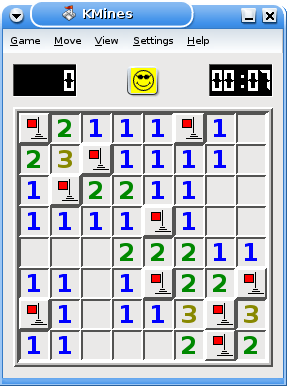Puzzle video game facts for kids
Puzzle video games are a fun type of video game where the main goal is to solve puzzles. These games challenge your brain in many ways! They can test your logic skills, how well you spot patterns, how you figure out sequences, and even your word completion abilities.
Sometimes, you have all the time in the world to solve a puzzle. Other times, there's a time limit, making even easy puzzles tricky, like in Tetris. Puzzle games are very different, but they often use colors, shapes, numbers, or even physics to create their challenges. Unlike many other games, puzzle games might give you a limited number of "lives" or tries. Players often aim for a high score or try to reach the next level by completing certain tasks.
Contents
What Are Puzzle Games?
Puzzle games are all about solving challenges that need thinking and planning. While many action games or adventure games have puzzles (like finding a hidden key), true puzzle games focus on solving puzzles as the main part of the game. These games often use shapes, colors, or symbols. You have to move or change them to create a specific pattern.
Instead of just giving you random puzzles, puzzle games usually have a series of puzzles that are all connected to one main idea. This idea could be about finding patterns, using logic, or understanding how something works. These games usually have simple rules. You move game pieces around on a grid or in a special area. You need to find clues to reach a goal, which then lets you move to the next level. Each puzzle you solve usually gets harder, but some games give you easier levels in between to keep it fun.
Different Kinds of Puzzle Games
There are many different kinds of puzzle games to enjoy!

Some games give you random blocks or pieces that you need to arrange correctly. Examples include Tetris, Klax, and Lumines. Other games give you a set game board or pieces and challenge you to reach a goal, like in Bomberman or The Incredible Machine.
Puzzle games are often easy to make and play on different devices. You can find them on arcade machines, home video game consoles, personal digital assistants, and mobile phones.
Action Puzzle Games
An action puzzle game means you have to move game pieces quickly, often on one screen and with a time limit. You need to solve the puzzle or clear the level before time runs out. This type includes games where blocks fall, like Tetris and KLAX. It also includes games where characters move through an area, like Lode Runner or Lemmings.
Sometimes, action puzzle games mix with other types. For example, a platform game that needs a special trick to finish levels might be called a "puzzle platformer", like Braid where you can change time. Other action puzzle games need good timing and accuracy, along with pattern-matching or logic skills. Examples include Portal and The Talos Principle.
Other well-known action puzzle games are Ico and Shadow of the Colossus by Team Ico. Ico has puzzles about moving through areas while protecting a friend. Shadow of the Colossus involves finding and using the weaknesses of giant monsters in fights. Nintendo's The Legend of Zelda: Breath of the Wild is another example. Its main goal is to find and solve puzzles based on physics to get upgrades for the final boss.
Hidden Object Games
A hidden object game (sometimes called hidden picture) is a puzzle game where you must find items from a list that are hidden inside a picture. These games are very popular for casual players and are usually not too expensive. You can often download free trial versions to try them out.
An early hidden object game was Alice: An Interactive Museum. Some of the first versions were video games based on the I Spy books, which started in 1997.
Some companies that make hidden object games include Sandlot Games, Big Fish Games, and Awem Studio. Popular hidden object game series include Awakening, Dream Chronicles, and Mystery Case Files.
Reveal the Picture Games
A reveal the picture game is a puzzle game where you slowly uncover a photo or picture piece by piece. An example you can play online is PicTAPr, which splits an image into 16 square pieces.
Physics Games

A physics game is a puzzle video game where you have to use the game's physics rules to solve each puzzle. These games use realistic physics to make the challenges harder. This type of game is very popular in online flash games and mobile games. Teachers have even used these games to show how physics works.
Some popular physics games include The Incredible Machine, World of Goo, Angry Birds, Cut the Rope, Portal, and Portal 2.
Tile-Matching Games
In tile-matching video games, you move tiles around to make them disappear by matching them in a certain way. This type of game started with Chain Shot! in 1985. It includes games where blocks fall, like Tetris, and games where you swap pieces, like Bejeweled or Candy Crush Saga. It also includes games that are like the classic tile-based game Mahjong, such as Mahjong Trails, and games where you shoot pieces onto the board, like Zuma. In many newer tile-matching games, you need to put a certain number of the same type of tiles next to each other. This number is often three, which is why they are called "match-three games."
Traditional Puzzle Games
Many classic puzzle games have also been made into video games. These include card games like solitaire and tile games like mahjong solitaire. Even familiar word puzzles and number puzzles have become games, such as Dr. Kawashima's Brain Training.
History of Puzzle Games
How Puzzle Games Started
Puzzle video games got their start from brain teasers and puzzles that people have enjoyed for a very long time. Old thinking games like Nim, Hangman, and Bulls and Cows (also known as Mastermind) were some of the first games to be put on computers.
In 1979, the University of Tokyo made Heiankyo Alien for the PC-8001 and arcades. This was an early "trap 'em up" puzzle action game. It was a bit like later puzzle action games such as Lode Runner. Another early action game with puzzle parts was Konami's Loco-Motion (1982). Parts of this game can be seen in Pipe Mania from LucasArts (1989).
Blockbuster (1981) was a computer version of the Rubik's Cube puzzle. Snark Hunt (1982) was a single-player game where you had to use logic to figure things out, similar to the 1970s Black Box board game. The crate-pushing puzzles in Sokoban from 1982 have been copied a lot and used in other games.
Other early puzzle games include puzzle-platformers like Door Door (1983), Lode Runner (1983), and Doki Doki Penguin Land (1985).
In 1984, the game Puzzle Panic for Atari computers even had "puzzle" in its name. That same year, Boulder Dash came out. In this action-puzzle game, you collect diamonds while avoiding or using rocks that fall when you dig dirt from under them. This game led to many similar "rocks and diamonds games."
In 1985, Chain Shot! introduced a new idea: removing groups of same-colored tiles on a grid, then having the remaining tiles fall into the empty space.
Tetris is famous for changing and making the puzzle game type popular. Alexey Pajitnov, a Soviet game designer, created the game in 1984. He was inspired by an old puzzle game called Pentomino, where players arrange falling blocks to make lines without gaps. Tetris became a huge success, selling 30 million copies just on the Game Boy.
Puzzle Games Get Better
In 1991, Lemmings was released. In this game, little creatures walk without thinking into dangerous spots. You have to give jobs to certain lemmings to guide them safely to a goal.
In 1994, there was a big rise in interest in mahjong video games from Japan.
When Minesweeper came out with Windows 95, many people started playing puzzle games using a computer mouse.
In 2001, PopCap Games released Bejeweled, which was a better-looking version of an older game called Shariki. In Bejeweled, you touch groups of three or more jewels on a grid to make them disappear, and new stones fall into place. Ten years later, this "match-three" idea became the basis for very popular games like Candy Crush Saga and Puzzle & Dragons, both from 2012.
By 2014, puzzle games had become the biggest type of game in the iOS App Store for mobile phones.
Images for kids
See also
 In Spanish: Videojuego de lógica para niños
In Spanish: Videojuego de lógica para niños


